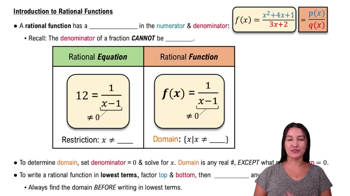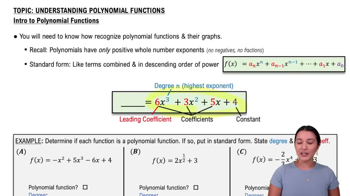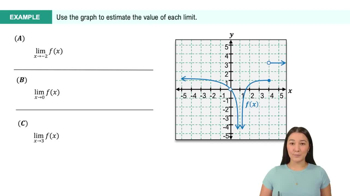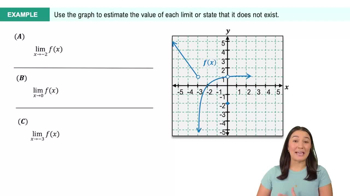Table of contents
- 0. Functions7h 52m
- Introduction to Functions16m
- Piecewise Functions10m
- Properties of Functions9m
- Common Functions1h 8m
- Transformations5m
- Combining Functions27m
- Exponent rules32m
- Exponential Functions28m
- Logarithmic Functions24m
- Properties of Logarithms34m
- Exponential & Logarithmic Equations35m
- Introduction to Trigonometric Functions38m
- Graphs of Trigonometric Functions44m
- Trigonometric Identities47m
- Inverse Trigonometric Functions48m
- 1. Limits and Continuity2h 2m
- 2. Intro to Derivatives1h 33m
- 3. Techniques of Differentiation3h 18m
- 4. Applications of Derivatives2h 38m
- 5. Graphical Applications of Derivatives6h 2m
- 6. Derivatives of Inverse, Exponential, & Logarithmic Functions2h 37m
- 7. Antiderivatives & Indefinite Integrals1h 26m
- 8. Definite Integrals4h 44m
- 9. Graphical Applications of Integrals2h 27m
- 10. Physics Applications of Integrals 2h 22m
1. Limits and Continuity
Introduction to Limits
Problem 2.4.53b
Textbook Question
Determine whether the following statements are true and give an explanation or counterexample.
The line x=−1 is a vertical asymptote of the function f(x) =x^2 − 7x + 6 / x^2 − 1.
 Verified step by step guidance
Verified step by step guidance1
Step 1: Identify the function f(x) = \frac{x^2 - 7x + 6}{x^2 - 1}. This is a rational function, which means it is a fraction where both the numerator and the denominator are polynomials.
Step 2: Determine the points where the denominator is zero, as these are potential vertical asymptotes. Set the denominator equal to zero: x^2 - 1 = 0.
Step 3: Solve the equation x^2 - 1 = 0. This can be factored as (x - 1)(x + 1) = 0, giving the solutions x = 1 and x = -1.
Step 4: Check if x = -1 is a vertical asymptote by ensuring it is not a removable discontinuity. Factor the numerator: x^2 - 7x + 6 = (x - 1)(x - 6).
Step 5: Since x = -1 does not cancel out with any factor in the numerator, it is indeed a vertical asymptote. Therefore, the statement is true.
 Verified video answer for a similar problem:
Verified video answer for a similar problem:This video solution was recommended by our tutors as helpful for the problem above
Video duration:
2mPlay a video:
Was this helpful?
Key Concepts
Here are the essential concepts you must grasp in order to answer the question correctly.
Vertical Asymptotes
A vertical asymptote occurs in a function when the function approaches infinity or negative infinity as the input approaches a certain value. This typically happens at values of x that make the denominator of a rational function equal to zero, provided that the numerator does not also equal zero at that point.
Recommended video:

Introduction to Cotangent Graph Example 1
Rational Functions
A rational function is a function that can be expressed as the ratio of two polynomials. The general form is f(x) = P(x)/Q(x), where P and Q are polynomials. Understanding the behavior of rational functions, especially their asymptotic behavior, is crucial for analyzing their graphs and determining points of discontinuity.
Recommended video:

Intro to Rational Functions
Factoring Polynomials
Factoring polynomials involves rewriting a polynomial as a product of its factors, which can simplify the analysis of functions. For example, the function f(x) = (x^2 - 7x + 6)/(x^2 - 1) can be factored to identify points where the function is undefined, helping to determine the presence of vertical asymptotes.
Recommended video:

Introduction to Polynomial Functions

 6:47m
6:47mWatch next
Master Finding Limits Numerically and Graphically with a bite sized video explanation from Callie
Start learning





